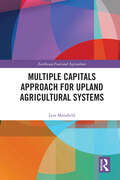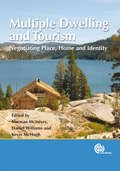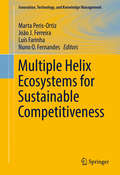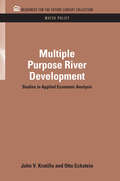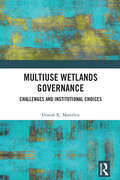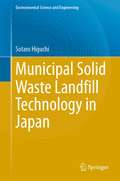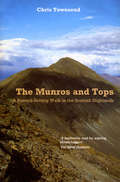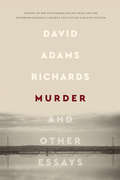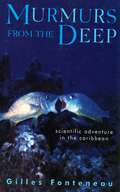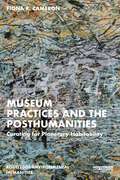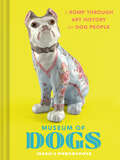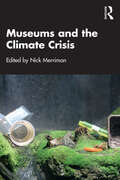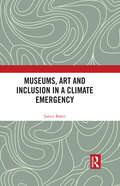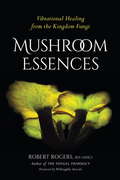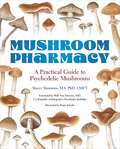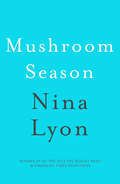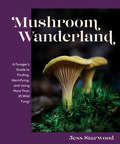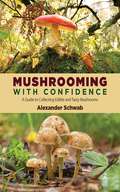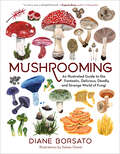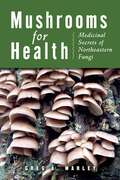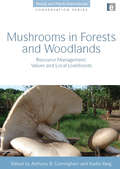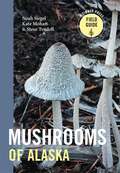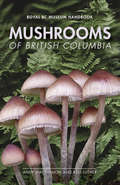- Table View
- List View
Multiple Capitals Approach for Upland Agricultural Systems (Earthscan Food and Agriculture)
by Lois MansfieldThis book focuses on upland agricultural systems and applies a multiple capitals approach to explain what they can provide at a time when many are struggling to survive.Marginal upland agricultural systems have been distorted and derailed by modern economics, politics, and the drive to intensification. This book argues for the application of a multiple capitals approach to resource management challenges for marginal upland agricultural communities. Instead of considering what upland agricultural systems lack, the book showcases how a multiple capitals framework can demonstrate the importance, interrelationships, and relevance of the suite of capitals (natural, human, social, cultural, and financial) to achieve better outcomes for upland communities, broader ecosystem services, and wider society more generally. It is designed to connect theory to practice to provide underpinning knowledge and guidance to help upland agricultural communities thrive. Drawing on case studies from the UK and Japan, as well as making comparisons with Central and South American countries, the book recommends tools for monitoring different forms of capital and suggests a management process driven by multiple capitals to create resilience in upland agricultural systems.This book will be of great interest to students and scholars of agriculture, natural resource management, ecosystem services, rural development, and those interested in applying a multiple capitals approach more widely within policy and landscape management contexts.
Multiple Dwelling and Tourism: Negotiating Place, Home and Identity
by Norman Mcintyre Daniel R. Williams Kevin E. MchughThe movement of people, goods, capital and information is a central aspect of living in the inter-connected, globalised late-modern world. Although this broader view of mobility is recognized, this book focuses mainly on migration or the movement of people and examines multiple dwelling as a societal response to the major influences of increased mobility and amenity tourism.
Multiple Helix Ecosystems for Sustainable Competitiveness
by Marta Peris-Ortiz João J. Ferreira Luís Farinha Nuno O. FernandesThis book discusses the main issues, challenges, opportunities, andtrends involving the interactions between academia, industry, government and society. Specifically, it aims to explore how these interactions enhance the ways inwhich companies deliver products and services in order to achieve sustainablecompetitiveness in the marketplace. Sustainable competitiveness has been widely discussed by academics andpractitioners, considering the importance of protecting the environment whilesustaining the economic goals of organizations. The Quintuple Helix innovation modelis a framework for facilitating knowledge, innovation and sustainablecompetitive advantage. It embeds the Triple and the Quadruple Helix models byadding a fifth helix, the "natural environment. " The Triple Helix model focuseson the university-industry-government triad, while the Quadruple adds civilsociety (the media- and culture-driven public) as a fourth helix. The Quintuple Helix model facilitates research, public policy, andpractical application of sustainable competitiveness principles. Applying themost recent developments and theoretical insights of this model, thecontributors to this volume address such questions as: how do government,academia, industry and civil society actors interact for promoting sustainablecompetitiveness at the country (regional) level? How do these actors influencesustainable operations management at the company (business) level? In so doing,they shed new light on the dynamics of economic growth, sustainability andcompetitiveness.
Multiple Purpose River Development: Studies in Applied Economic Analysis (RFF Water Policy Set)
by John V. Krutilla Otto EcksteinThis book sketches out a framework for analyzing the economic efficiency of particular river basin programs. It provides a useful cross-disciplinary perspective for economists and water resource developers-especially designed to provide working material for students in applied economics for conservation curricula. Originally published in 1958.
Multiuse Wetlands Governance: Challenges and Institutional Choices
by Dinesh K. MarothiaThe Ramsar Convention was established in 1971 to ensure the conservation and wise use of wetlands across the world. India joined the Convention in 1982, however, in the past 50 years despite Ramsar’s incredible achievements, the threat to wetlands across the globe, including India, has not diminished. This book studies the governance of multiuse wetlands in India. The volume provides an exhaustive analysis of rural, peri-urban and urban human-made wetlands to establish the relevance of institutional design and the effective role of authority in governing multiuse wetland ecosystem services. The author argues that the most challenging task in governing wetlands is to frame institutional choices that users and non-users comprehend, and agree to pursue under alternative property rights regimes. Drawing on extensive fieldwork, the book provides a broader look into the causes and consequences of wetland ecosystem degradation and offers insights into improved sustainable management systems for different types of multiuse wetlands. It will be indispensable for students and researchers of environmental studies, sustainable development, biodiversity, conservation, agricultural, natural, and environmental resource economics.
Municipal Solid Waste Landfill Technology in Japan (Environmental Science and Engineering)
by Sotaro HiguchiJapan was ahead of the rest of the world when it introduced intermediate processing of municipal waste by such means as incineration in the 1960s. Owing to the small land area of the country and the difficulty in securing landfill sites, the incineration ratio of municipal combustible waste had reached 100% by the 1990s. Along with the landfill of incineration residues, proprietary technologies such as high salt leachate treatment, desalination treatment, by-product recycling, a focus on the resource of incineration residues, sea surface landfill sites, and covered type landfill sites have spread and developed since then. This book describes the introduction of incineration facilities starting in the 1960s, landfill technology, and issues arising after 1990 following the introduction of the facilities. The necessity of a total system from incineration to landfill is explained as well. The volume is a valuable resource for countries that plan to introduce intermediate processing such as incineration and for countries that are developing a waste management policy.
Munros and Tops, The: A Record-Setting Walk in the Scottish Highlands
by Chris TownsendWhen Chris Townsend reached the summit of Ben Hope in Sutherland, he walked his way into the record books. After 118 days in which he had covered more than 1,700 miles and climber over 575,000 feet, he had completed the first single continuous journey of all 277 Munros and 240 Tops in the Scottish Highlands.This is the story of that remarkable walk from the start on Ben More on the Isle of Mull through to the finish, the equivalent of climbing Mount Everest 18 times. For the author, the real enjoyment of the walk was not in counting up the summits or the miles but in spending week after week in the hills and living in the wilds. In THE MUNROS AND TOPS, Chris Townsend recalls the joys of observing the birds and animals, the trees and flowers, the changing shapes of the hills and the play of light on their slopes. He writes about the complexities of route-finding and the challenge of rugged terrain and of coping with often atrocious weather conditions. Illustrated with photographs taken during the walk, this is a stirring account of a unique achievement.
Murder: And Other Essays
by David Adams RichardsA thrilling, revelatory collection from one of the most provocative and original literary voices in Canada today.David Adams Richards is one of Canada's greatest writers, his place in the pantheon ensured by seventeen novels of consistent power and vision. He is also the author of four marvelous non-fiction ruminations on religious faith, hockey, hunting and fishing and their roles in his and the nation's identities. His loyal readers may feel they know him well. But they also know that this is a writer who never fails to surprise. This new collection of essays--his first in a quarter-century--is rich with revelations and insights, deepening our appreciation for this major talent and offering a provoking thought on every page. Murder is one of David's great subjects. In his novels, in the Russian classics he loves and in his life, murder has been a shaping force. The title of this volume refers to a suite of essays on the subject: a hitchhiker with whom David strikes up an unnerving philosophical debate; the killers of the Miramichi and their victims; Caligula; the villains of Russian literature; and, forever in David's mind as he examines this grim topic, the self-deception involved in the allure of evil. But in this wide-ranging collection there is much to delight in too: married love; family; travel; the beauty of the natural world; even Wayne Gretzky is invited to the party. David's principled outlook and spirituality inform his thinking thoroughout. And he draws many of his favourite writers into the discussion--from Tolstoy to Dostoevsky, Mary Shelley to Alden Nowlan--revelling in their work, as we do in David's, as sources of ideas, inspiration and sheer literary pleasure. As a considerable bonus, the book also contains at its midpoint a literary debut: a slim but substantial collection of David's poetry.
Murmurs From The Deep: Scientific Adventures in the Caribbean
by Gilles FonteneauA scientific expedition into unknown parts of the Caribbean to study the tectonic plates of the region answers the intriguing question: Is there a language of fish? Gilles Fonteneau, a longtime colleague of the legendary Jacques Cousteau's Calypso team, fulfilled a lifelong dream when in 2001 he launched his own exploration, aboard the 45-foot catamaran Prince de Vendee, into the silent world of the sea. Little did he know when he set out that his efforts to better understand the dynamics of the tectonic plates of the region would have such worldwide significance, as shown by the tsunami disaster of southeast Asia in December 2004. His second goal, sponsored by NASA and the Bacardi Family Foundation, to make acoustic recordings of the region's fish, produced startling results, which will go a long way toward understanding and protecting threatened species. As fascinating as it is scientifically revealing, Murmurs From The Deep sheds new light on the ever-mysterious underwater world.
Museum Practices and the Posthumanities: Curating for Planetary Habitability (Routledge Environmental Humanities)
by Fiona R. CameronThis book critiques modern museologies and curatorial practices that have been complicit in emerging existential crises. It confidently presents novel, more-than-human curatorial visions, methods, frameworks, policies, and museologies radically refiguring the epistemological foundations of curatorial, museological thinking, and practice for a habitable planet. Modern curatorial and museological practices are dominated by modern humanism in which capital growth, social, technological advancement, hubris, extraction, speciest logics, and colonial domination predominate, often without reflection. While history, science, and technology museums and their engagement with non-human worlds have always been ecological as an empirical reality, the human-centred frameworks and forms of human agency that institutions deploy tend to be non-cognizant of this reality. Museum Practices and the Posthumanities: Curating for Planetary Habitability reveals how these practices are ill-equipped to deal with the contemporary world of rapid digital transformations, post-Covid living, climate change, and its impacts among other societal changes, and it shows how museums might best meet these challenges by thinking with and in more-than-human worlds. This book is aimed at museological scholars and museum professionals, and it will provide them with the inspiration to conduct research on and curate from a different ecological reference point to promote a world good enough for all things to thrive in radical co-existence.
Museum of Dogs: A Romp through Art History for Dog People
by Jessica PoundstoneJourney into your own pocket-sized museum, filled with a collection of charming art-historical pups! Ready to meet a pack of very good dogs immortalized in painting and sculpture? This quirky and fascinating little book collects the best canines in art history, including:Rustic figurines carved in ancient GreeceElegant porcelain pooches handcrafted in 19th-century RussiaA tiny Japanese netsuke in the shape of a puppyA portrait of a spaniel woven by a beadwork artisan in MexicoAnd so much more!Artist and writer Jessica Poundstone has scoured the world's museum collections for these hidden treasures and offers fun and informative commentary on each. Her bite-sized text gives historical context and celebrates each dog’s sweet, noble, or wacky personality, which transcends history to hit us right in the feels. This delightful volume offers pure delight for dog lovers and art lovers alike.PERFECTLY GIFTABLE: This is a charming gift for people who love art and dogs! A petite and beautifully designed hardcover book, it makes an entertaining and educational present for friends and family or a treat for yourself. It's simply impawsible to resist.CURATED COLLECTION: Flipping through this art book is like getting a special guided tour of a wondrous museum devoted entirely to our furry friends. In a world of sensory overload, it offers a wonderful way to tap into the joy of something curated just for you. FUN ANGLE ON FINE ART: Whether you are a devoted museumgoer or casually art-curious, this book offers a unique and delightful spin on art history. The content covers a wide range of styles, media, and eras, creating a perfect opportunity to brush up on your art IQ with the help of man's best friend.Perfect for:Animal loversArt and art history buffsGift-giving to dog owners, artists, and collectorsFans of art/humor crossovers like Men to Avoid in Art and Life and William Wegman: Being HumanFans of clever art history like Art Dog and A History of Art in 21 Cats
Museums and the Climate Crisis
by Nick MerrimanMuseums and the Climate Crisis shows how museums can respond to the interrelated global climate, biodiversity and pollution crises. They have a unique role because they take a long-term perspective, and their scholarship and independence mean that they remain trusted by the public. Providing insights and international case studies from a range of museum and gallery professionals, academics and consultants, this book explores how museums can use this unique perspective to engage the public as active citizens, and how they are exemplars of good practice in areas such as emissions reduction and encouraging biodiversity. It shows how museums can combat climate exhaustion by drawing on understandings about positive motivation, and how to develop exhibitions, events and activities that motivate visitors to take action. Taking a broad approach beyond purely climate issues, the contributions touch on the use of renewables, environmental controls and standards, travel (including virtual couriering), waste management (including recycling, plastic reduction and composting), reducing pollution and increasing biodiversity within museums. Museums and the Climate Crisis will be important reading to those studying in the fields of Museum Studies, Heritage Studies and Conservation. Taking a practical approach, it will also be beneficial to museum, gallery and heritage professionals who are grappling with the challenges of the climate crisis.
Museums, Art and Inclusion in a Climate Emergency
by Janice BakerMuseums, Art and Inclusion in a Climate Emergency considers the impact of the Anthropocene on history and memory, approaches to objects and agency and the incommensurability of western and Indigenous ontologies. Drawing on Indigenous knowledge, humanities and museological literature, continental philosophy, contemporary art and popular culture, Baker acknowledges the autonomous agency of geological forms, including soils, minerals and fossil fuels. Demonstrating that this has implications for an expanded idea of an ‘inclusive’ museum and its relationship to entities beyond ‘life’ and living species, the book argues that the ‘inclusion’ paradigm needs to include nonlife actors. Gesturing to a geontological ‘turn’ through developing notions of geo-inclusion, the mineralhuman and approaches to object agency that connect with Aboriginal ‘heritage’, Baker exposes the ongoing destruction of Country by mining interests in Western Australia and elsewhere. By addressing the need for urgent change through the artifice of the museum, the book identifies an expanded approach to inclusion beyond the limits imposed by the politics of identity. Museums, Art and Inclusion in a Climate Emergency theorises the potential of an expanded idea of the museum and will be of interest to scholars and students engaged in the study of museums and heritage, environmental humanities and geo-humanities, ecological art history and contemporary art.
Mushroom Day: A Story of 24 Hours and 24 Fungal Lives (Earth Day)
by Alison PouliotAn hourly guide that spotlights twenty-four fungus species as they spread spores, find food, and adapt to a changing planet. On this mushroom-filled day, ecologist Alison Pouliot tours the world to introduce readers to a fascinating variety of fungi. Each chapter of Mushroom Day introduces a single fungus during a single hour, highlighting twenty-four different species. In the dark of the night, the green glow of the ghost fungus guides us into the forest to learn about the mysteries of bioluminescence. At dawn, we awaken to find a fairy ring of mushrooms that has appeared overnight like something out of folklore. But we don’t have much time to linger, as we must reach the Italian forest before other porcino hunters forage the morning’s fattest and finest. In the heat of the afternoon, the ripe stench of the stinkhorn might send us out of the woods, while the enticing aroma of the aniseed funnel lures us back in. Late in the evening we spy a fungus known as the witches cauldron and wonder what it might tell us about the future. By the end of our mushroom day, we’ll have glimpsed the diversity of this unique kingdom, met fungus friends that feed and fascinate, and learned how humans can encourage their flourishing. For each hour, celebrated artist Stuart Patience has depicted these scenes with evocative pen and ink illustrations. Working together to narrate and illustrate these unique moments in time, Pouliot and Patience have created an engaging read that is a perfect way to spend an hour or two—and a true gift for foragers, mycophiles, and anyone who wants to stop and appreciate fungi.
Mushroom Essences: Vibrational Healing from the Kingdom Fungi
by Robert Rogers Willoughby ArevaloIn this innovative contribution to the field of energy medicine, experienced mycologist and herbalist Robert Rogers offers an extensive guide to healing a range of physical, emotional, and psychological conditions with mushroom essences. Similar to flower essences, but made under a lunar cycle, mushroom essences work subtly to bring deep healing to the mind and body; they are particularly well suited for working with the "shadow" or unintegrated parts of the psyche. The book is organized as an easy-to-use alphabetical reference, with entries that outline how to create each essence, indications for usage, and healing effects. Along the way, Rogers provides enlivening stories of his personal experience using these remedies in clinical practice. A profound exploration of both the practical and mythopoetic qualities of the mushroom, this is a must-have for anyone interested in plant medicine, mycology, personal healing, or depth psychology.From the Trade Paperback edition.
Mushroom Pharmacy: A Practical Guide to Psychedelic Mushrooms
by Stacey SimmonsA practical, approachable guide to using psilocybin, the psychedelic compound found in mushrooms, for health and wellness, including information on varietals, microdosing, and the treatment of an array of mental and psychical ailments. Psilocybin is proving to have profound impact on health and wellness, particularly in the areas of mental health and addiction. From author and certified psychedelic therapist Stacey Simmons, MA, PhD, LMFT, Mushroom Pharmacy is the first comprehensive, easy-to-understand guide to using mushrooms safely and effectively to alleviate symptoms, and potentially cure the underlying causes, of dozens of ailments from depression, anxiety, and addiction to OCD, PTSD, Lyme Disease, Alzheimer's Disease, Migraines and more. In this deeply researched, practically oriented guide, Dr. Simmons helps readers understand how psilocybin acts on the brain, the key elements of responsible psychedelic therapy, and how the effects of this practice can lead to deep and permanent healing. The book also educates readers in the practical aspects of how to responsibly forage for or grow their own mushrooms, how to identify and use different more than 30 different psychedelic mushroom varieties, and how to understand the dosing and administration of psychedelics. Written by an expert in the field, this groundbreaking work is a must-have for anyone interested in the brave new world of psychedelic medical treatment.
Mushroom Season
by Nina Lyon'Mushroom Season' is a ramble through magic mushrooms, mountains and metaphysics. After heavy sanctions relegated their use to a spell in the stoner wilderness, are psilocybin mushrooms about to help reframe important social and philosophical debates about our minds, and ourselves?Where do they grow? What do they do to our brains? And why are they eschewed by the bourgois? Nina Lyon introduces us to Liberty Caps and Fly Agarics, the characters she encountered as a student tripper and the differences between home-grown hallucinogens and Mexican export. Among the anecdotes and observations are chemical facts, etymological revelations and philosophical speculation. Why are mushrooms subject to social stigma? What are the good effects they might have on us? And how does illegalisation damage a culture of free-thinking and experiment? Taking apart the teenage clichés and middle-class prejudice associated with the drug, Nina Lyon provides a wonderfully entertaining history of the magic mushroom.
Mushroom Wanderland: A Forager's Guide To Finding, Identifying, And Using 25 Wild Fungi
by Jess StarwoodThe breathtaking beauty of mushrooms from a master forager: how to identify and use them in cooking, home remedies, and spirituality. Foraging for mushrooms is a meditative and rewarding escape. Even if readers aren’t ready to head out into the woods, this enchanting visual guide is a welcome introduction to 25 easily identifiable species, organized by location and use. Author Jess Starwood has led hundreds of foraging trips, sharing her knowledge of nature with students. This, her first book, is a celebration of fungi—perfect for both beginner and longtime mushroom admirers. No matter their use, all mushrooms have specific characteristics that are easy to recognize with the right teacher. Under Starwood’s guidance, readers will learn to identify caps, stipes, gills, and pores. They’ll encounter species such as Reishi, Lion’s Mane, Candy Cap, Chanterelle, and more; learn the best harvesting seasons; and enjoy delicious recipes using culinary favorites. But, above all, this guide will have readers growing their connection to nature and dreaming of the wonderful world of fungi.
Mushrooming with Confidence: A Guide to Collecting Edible and Tasty Mushrooms
by Alexander SchwabPicking mushrooms in the woods on a sunny day can be fun for the whole family . . . but only if you do it safely! There are thousands of different species of fungi, so it can be hard to tell which are edible and which are poisonous when you are picking them for yourself in the wild. Safe and unsafe species often closely resemble each other, and worrying about which mushrooms are safe and which might be deadly can take all the fun out of mushrooming. Enter Mushrooming with Confidence! Improving on the usual overwhelming and exhaustive wild plant guidebook, Mushrooming with Confidence is a slim, handy manual that focuses on the tastiest and most common mushrooms, so that you can easily spot those that are not only safe to eat, but also a delight to cook and share! Here mushrooms are divided into four identification categories so that anyone will be able to recognize what he or she is looking at quickly and correctly. Thirty of the most common and delicious types are explained in detail, from the common field mushroom to the pretty purple amethyst deceiver and the prolific and tasty charcoal burner. Each mushroom includes a “Positive ID Checklist” that the reader can go through to be absolutely certain they have the right species, and more than 300 color photographs make it a snap to know exactly what kind of mushroom you’ve found . . . and whether you really want to pick it! With lists of the best tools for mushrooming, the best techniques for getting a mushroom out of the ground in one piece, and even how to remove worms, Mushrooming with Confidence will extinguish any fear or doubt that might stop you from hunting down your own delicious mushrooms. This will prove a fun and essential guide for novice and experienced pickers alike!
Mushrooming: An Illustrated Guide To The Fantastic, Delicious, Deadly, And Strange World Of Fungi
by Diane Borsato“A merry, idiosyncratic guide, charmingly illustrated.”—Eugenia Bone, The Wall Street Journal An illustrated guide to over 100 types of mushrooms, offering insights and stories about these mysterious organisms An incredible diversity of fungi is flourishing all around us, not just in the forest but in parks, markets, and even museums. Once you know how to look, you can find mushrooms named after fairies and demons, mushrooms that look so much like woodland birds they are shot at by hunters, mushrooms that glow in the dark . . . and so much more. Beyond serving as a guide for identification, Mushrooming explores how “the quiet hunt” can radically expand our perspectives, connect us to nature, and enrich our lives. Whether you’re a beginner forager or an expert mycophile, this is the perfect handbook to spark your curiosity and deepen your appreciation for the fantastic, delicious, deadly, and strange world of fungi.
Mushrooms Demystified: A Comprehensive Guide to the Fleshy Fungi of the Central California Coast
by David AroraMushrooms Demystified can serve almost anywhere as a general introduction to wild mushrooms, especially when used in conjunction with other regional guides.
Mushrooms for Health: Medicinal Secrets of Northeastern Fungi
by Greg MarleyThere is a burgeoning interest in natural medicines in the United States. Among these natural health powerhouses are mushrooms, and here mycologist Greg Marley introduces ten species found in New England-and elsewhere, too, in many cases. Marley describes where to find and how to prepare these fungi and lists their health-supporting benefits. On a comforting note, Marley says there are no poisonous look-alikes for any of these beneficial fungi!
Mushrooms in Forests and Woodlands: Resource Management, Values and Local Livelihoods (People and Plants International Conservation)
by Anthony B. Cunningham Xuefei YangMany mushrooms - or the 'fruits of fungi' - are extremely valuable, wild-gathered products which are utilised for both their medicinal properties and as food. In many of the world's tropical and temperate forests, they are the primary source of income for the people who live there. These forests range from temperate woodlands and small forests to high altitude forests in the Himalaya and tropical miombo woodlands in south-central Africa. In south-west China, over 200 species of wild fungi in 64 genera are commercially traded while in Europe and North America, woodlands and small forests are the source of many highly-prized mushrooms and an essential resource for many small enterprises and collectors. Yet the increased demand for timber has resulted in the rapid expansion of forestry, which in turn has destroyed the natural habitat of many fungi, unbalancing both forest economics and ecology. Despite the economic, social and cultural values of fungi, there is a general lack of understanding of their importance to local livelihoods and forest ecology. This book aims to fill this gap and extends the People and Plants Conservation Series beyond the plant kingdom into the related world of fungi and mushrooms. It demonstrates the crucial roles that fungi play in maintaining forest ecosystems and the livelihoods of rural people throughout the world while providing good practice guidelines for the sustainable management of this resource and an assessment of economic value. It brings together the perspectives of biologists, anthropologists and forest and woodland managers to provide a unique inter-disciplinary and international overview of the key issues.
Mushrooms of Alaska (A Timber Press Field Guide)
by Noah Siegel Steve Trudell Kate MohattIdeal for foragers, hikers, and birders, Timber Press Field Guides are the perfect tools for loving where you live From the leading experts on Northwest mycology comes this comprehensive field guide to the most conspicuous, distinctive, and ecologically important mushrooms found in the Last Frontier. With helpful identification keys and photographs and a clear, color-coded layout, Mushrooms of Alaska is the perfect companion for locals and visitors alike. Describes and illustrates more than 400 species of fungi Over 500 spectacular photographs, with additional keys and diagrams Includes rare species not illustrated in other guides Easy to use for beginners and experts
Mushrooms of British Columbia (Royal BC Museum Handbook)
by Kem Luther Andy MacKinnon“This book will expand the pleasure and knowledge of anyone who spends time in nature.”— Robert BatemanWith more species of fungi than any other region in Canada, British Columbia is a rich playground for mushroom hunters. Now there's Mushrooms of British Columbia, the newest handbook from the Royal BC Museum. It's perfect for anyone wanting to know more about BC mushrooms—whether for study, harvest, photography or appreciation.Authors and mushroom experts Andy MacKinnon and Kem Luther bring a practical and playful approach to helping people quickly and confidently identify the mushrooms of British Columbia. Common names trump technical terminology, fungi are grouped by overall shape, and written descriptions of more than 350 common species are reinforced with carefully curated diagnostic images.This is the go-to guidebook for anyone, amateur or expert, who loves to study, draw, photograph and eat BC mushrooms.
